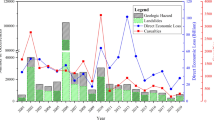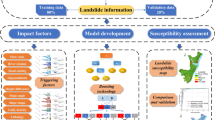Abstract
Landslide is a major disaster threatening the safety and orderly production of an open-pit mine, so slope stability evaluation is of great significance to the support and monitoring arrangement. Landslide susceptibility mapping (LSM) was widely used in landslide prediction. The former research focused on the algorisms to improve its accuracy, which is relatively complete and left little room for further improvement. In this paper, new factors, including RQD and numerical simulation (NS), are selected to solve the limitation of traditional LSM on the integrity and stress state of the slope. The RQD value was obtained by machine learning and converted into rasters by the ordinary Kriging interpolation method. The slope stress was calculated by the finite difference method and converted into raster data using a program written by Fish language. Based on the information value (INV) method, gradient boosting decision tree (GDBT) was used as the main algorism to generate the LSM-NS. Finally, because LSM-NS contains landslides that have already occurred and those in high susceptibility due to its stress state, commonly used validation methods such as AUROC could no longer be used. Multiple validation methods were applied, such as stress monitoring and UAV tilt photography. The result indicates that the stress increases with crack generating in the high susceptibility area of LSM-NS, where traditional LSM could not predict. Therefore, the addition of RQD and NS could further improve the accuracy using existing algorism. LSM-NS is recommended as the more suitable model for landslide susceptibility assessment in a small area due to its excellent accuracy and efficiency.










Similar content being viewed by others
References
Abedini M, Tulabi S (2018) Assessing LNRF, FR, and AHP models in landslide susceptibility mapping index: a comparative study of Nojian watershed in Lorestan province. Iran Environ Earth Sci 77:405. https://doi.org/10.1007/s12665-018-7524-1
Akgun A, Erkan O (2016) Landslide susceptibility mapping by geographical information system-based multivariate statistical and deterministic models: in an artificial reservoir area at Northern Turkey. Arab J Geosci 9:165. https://doi.org/10.1007/s12517-015-2142-7
Anwer RM, Khan FS, van de Weijer J, Molinier M, Laaksonen J (2018) Binary patterns encoded convolutional neural networks for texture recognition and remote sensing scene classification. ISPRS J Photogramm Remote Sens 138:74–85. https://doi.org/10.1016/j.isprsjprs.2018.01.023
Azarafza M, Azarafza M, Akgün H, Atkinson PM, Derakhshani R (2021) Deep learning-based landslide susceptibility mapping. Sci Rep 11:24112. https://doi.org/10.1038/s41598-021-03585-1
Bandara S, Ohtsuka S (2017) Spatial distribution of landslides induced by the 2004 Mid-Niigata prefecture earthquake, Japan. Landslides 14:1877–1886. https://doi.org/10.1007/s10346-017-0819-6
Bui DT, Ho TC, Pradhan B, Pham BT, Nhu VH, Revhaug I (2016) GIS-based modeling of rainfall-induced landslides using data mining-based functional trees classifier with AdaBoost, Bagging, and MultiBoost ensemble frameworks. Environ Earth Sci 75:1–22
Chen T, Zhu L, Niu R-q, Trinder CJ, Peng L, Lei T (2020) Mapping landslide susceptibility at the Three Gorges Reservoir, China, using gradient boosting decision tree, random forest and information value models. J Mt Sci 17:670–685. https://doi.org/10.1007/s11629-019-5839-3
Chen W, Chen X, Peng J, Panahi M, Lee S (2021) Landslide susceptibility modeling based on ANFIS with teaching-learning-based optimization and Satin bowerbird optimizer. Geosci Front 12:93–107. https://doi.org/10.1016/j.gsf.2020.07.012
Chen W, Pourghasemi HR, Naghibi SA (2017a) A comparative study of landslide susceptibility maps produced using support vector machine with different kernel functions and entropy data mining models in China Bull Eng Geol Environ 77 647-664
Chen W, Pourghasemi HR, Zhao Z (2017b) A GIS-based comparative study of Dempster-Shafer, logistic regression and artificial neural network models for landslide susceptibility mapping. Geocarto Int 32:367–385. https://doi.org/10.1080/10106049.2016.1140824
Elith J, Leathwick JR, Hastie T (2008) A working guide to boosted regression trees. J Anim Ecol 77:802–813. https://doi.org/10.1111/j.1365-2656.2008.01390.x
Fell R, Corominas J, Bonnard C, Cascini L, Savage WZ (2008) Guidelines for landslide susceptibility, hazard and risk zoning for land-use planning. Eng Geol 102(3-4):85–98
Friedman JH (2002) Stochastic gradient boosting. Comput Stat Data Anal 38:367–378. https://doi.org/10.1016/S0167-9473(01)00065-2
He H, Hu D, Sun Q, Zhu L, Liu Y (2019) A landslide susceptibility assessment method based on GIS technology and an AHP-weighted information content method: a case study of southern Anhui, China. ISPRS Int J Geo-Inform 8:266
Huan Y, Song L, Khan U, Zhang B (2022) Stacking ensemble of machine learning methods for landslide susceptibility mapping in Zhangjiajie City, Hunan Province, China. Environ Earth Sci 82:35. https://doi.org/10.1007/s12665-022-10723-z
Kumar M, Rana S, Pant PD, Patel RC (2017) Slope stability analysis of Balia Nala landslide, Kumaun Lesser Himalaya, Nainital, Uttarakhand, India Journal of Rock Mechanics and Geotechnical. Engineering 9:150–158
Lin G-F, Chang M-J, Huang Y-C, Ho J-Y (2017) Assessment of susceptibility to rainfall-induced landslides using improved self-organizing linear output map, support vector machine, and logistic regression. Eng Geol 224:62–74. https://doi.org/10.1016/j.enggeo.2017.05.009
Lin M, Teng S, Chen G, Hu B (2023) Application of convolutional neural networks based on Bayesian optimization to landslide susceptibility mapping of transmission tower foundation. Bull Eng Geol Environ 82:51. https://doi.org/10.1007/s10064-023-03069-8
Liu F, Yang T, Zhou J, Deng W, Yu Q, Zhang P, Cheng G (2020a) Spatial variability and time decay of rock mass mechanical parameters: a landslide study in the Dagushan open-pit mine. Rock Mechanics and Rock Engineering
Liu F, Yang T, Zhou J, Deng W, Yu Q, Zhang P, Cheng G (2020b) Spatial variability and time decay of rock mass mechanical parameters: a landslide study in the Dagushan open-pit mine. Rock Mech Rock Eng 53:3031–3053. https://doi.org/10.1007/s00603-020-02109-z
Liu H, Shi W, Yang T (2020c, 2020) Numerical modeling on anisotropy of seepage and stress fields of stratified rock slope. Math Probl Eng:4956025. https://doi.org/10.1155/2020/4956025
Madani N, Yagiz S, Coffi Adoko A (2018) Spatial mapping of the rock quality designation using multi-Gaussian Kriging method. Minerals 8:530
Matsukura Y, Mizuno K (1986) The influence of weathering on the geotechnical properties and slope angles of mudstone in the Mineoka earth-slide area, Japan. Earth Surf Process Landf 11:263–273. https://doi.org/10.1002/esp.3290110304
Mondal S, Maiti R (2013) Integrating the Analytical Hierarchy Process (AHP) and the frequency ratio (FR) model in landslide susceptibility mapping of Shiv-khola watershed, Darjeeling Himalaya. Int J Disaster Risk Sci 4:200–212. https://doi.org/10.1007/s13753-013-0021-y
Pham BT, Jaafari A, Prakash I, Bui DT (2018) A novel hybrid intelligent model of support vector machines and the MultiBoost ensemble for landslide susceptibility modeling. Bull Eng Geol Environ 78:2865–2886
Schapire RE, Rochery M, Rahim M, Gupta N (2005) Boosting with prior knowledge for call classification. IEEE Trans Speech Audio Process 13:174–181. https://doi.org/10.1109/TSA.2004.840937
Tao Z, Shu Y, Yang X, Peng Y, Chen Q, Zhang H (2020) Physical model test study on shear strength characteristics of slope sliding surface in Nanfen open-pit mine. Int J Min Sci Technol 30:421–429. https://doi.org/10.1016/j.ijmst.2020.05.006
Tien Bui D, Tuan TA, Hoang ND, Thanh NQ, Nguyen D, Van Liem N, Pradhan B (2017) Spatial prediction of rainfall-induced landslides for the Lao Cai area (Vietnam) using a hybrid intelligent approach of least squares support vector machines inference model and artificial bee colony optimization. Landslides 14:1–12
Umrao RK, Singh R, Sharma LK, Singh TN (2017) Soil slope instability along a strategic road corridor in Meghalaya, north-eastern India. Arab J Geosci 10:260. https://doi.org/10.1007/s12517-017-3043-8
Westen CJ, Bonilla JBA (1994) Mountain hazard analysis using a PC-based GIS [C]. Proceedings Seventh International Congress. International Association of Engineering Geology
Xie J, Uchimura T, Chen P, Liu J, Xie C, Shen Q (2019) A relationship between displacement and tilting angle of the slope surface in shallow landslides. Landslides 16:1243–1251. https://doi.org/10.1007/s10346-019-01135-5
Xie M, Esaki T, Qiu C, Wang C (2006) Geographical information system-based computational implementation and application of spatial three-dimensional slope stability analysis. Comput Geotech 33:260–274. https://doi.org/10.1016/j.compgeo.2006.07.003
Yang Z, Li S, Yu Y, Liu X, Hu Y (2020) Study on the variation characteristics of the anchor cable prestress based on field monitoring in a foundation pit. Arab J Geosci 13:1269
Yin KL, Yan TZ Statistical prediction models for slope instability of metamorphosed rocks. In: Proc International Symposium on Landslides, 1988
Zhang F, Yang T, Li L, Wang Z, Xiao P (2019) Cooperative monitoring and numerical investigation on the stability of the south slope of the Fushun west open-pit mine. Bull Eng Geol Environ 78:2409–2429. https://doi.org/10.1007/s10064-018-1248-z
Zhang H, Adoko AC, Meng Z, Hao W, Jiao Y (2016) Mechanism of the mudstone tunnel failures induced by expansive clay minerals. Geotech Geol Eng 35:1–13
Zhang L (2010) Estimating the strength of jointed rock masses. Rock Mech Rock Eng 43:391–402. https://doi.org/10.1007/s00603-009-0065-x
Zhang W, Wang Q, Chen JP, Tan C, Yuan XQ, Zhou FJ (2012) Determination of the optimal threshold and length measurements for RQD calculations. Int J Rock Mech MinSci 51:1–12. https://doi.org/10.1016/j.ijrmms.2012.02.005
Zhang Z, Zhou A, Huang P, Yang R, Ma C (2021) Using AHP-VW model to evaluate the landslide susceptibility—a case study of Zigui County, Hubei Province, China. Arab J Geosci 14:2095. https://doi.org/10.1007/s12517-021-08476-3
Zou Q et al (2021) A new approach to assess landslide susceptibility based on slope failure mechanisms. CATENA 204:105388. https://doi.org/10.1016/j.catena.2021.105388
Acknowledgements
In addition, we would like to thank anonymous reviewers and the editor for constructive comments that helped improve this manuscript.
Funding
This paper was supported by the National Natural Science Foundation of China (U1903216, 52174070).
Author information
Authors and Affiliations
Corresponding author
Ethics declarations
Conflict of interest
The authors declare no competing interests.
Rights and permissions
Springer Nature or its licensor (e.g. a society or other partner) holds exclusive rights to this article under a publishing agreement with the author(s) or other rightsholder(s); author self-archiving of the accepted manuscript version of this article is solely governed by the terms of such publishing agreement and applicable law.
About this article
Cite this article
Wang, H., Yang, T., Zhang, P. et al. Landslide susceptibility prediction considering rock integrity and stress state: a case study. Bull Eng Geol Environ 82, 259 (2023). https://doi.org/10.1007/s10064-023-03250-z
Received:
Accepted:
Published:
DOI: https://doi.org/10.1007/s10064-023-03250-z




